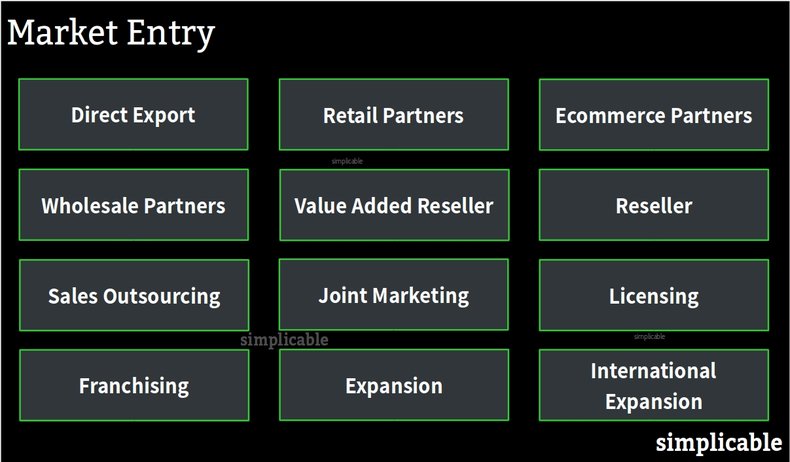

Direct Export
Directly exporting products and services to new regions and countries. For example, the ecommerce site of an American fashion retailer that begins shipping to Europe.Retail Partners
Finding local retail partners to sell your products in new markets. For example, a French luxury bakery and sweets maker that partners with a Japanese department store to reach customers in Japan.Ecommerce Partners
Selling to ecommerce platforms and sellers in new markets. For example, a craftsperson in the UK who begins to sell to an ecommerce seller in Japan who specializes in importing UK products.Wholesale Partners
Exporting your goods to a wholesaler in a new market. This only works if there is demand for your product amongst local retailers and ecommerce sellers. For example, if your brand is well known on an international basis.Value Added Reseller
Selling your products and services to a partner that will incorporate them into their products. For example, a German manufacturer of brakes for bicycles that sells to a bicycle manufacturer in China.Reseller
A partner that resells your products or services into a new market without adding much value. For example, an IT consulting company in Italy that sells subscriptions to an American software service.Sales Outsourcing
Contracting a third party to sell your products and services in a new market. For example, a software as a service company that opens up a sales office in Singapore that is fully owned and operated by an outsourcing partner.Joint Marketing
Selling through a distribution partner such a retailer, ecommerce company or wholesaler with an agreement regarding marketing support. For example, the distribution partner may require that you conduct local advertising to generate demand.Licensing
Licensing your intellectual property such as trademarks. For example, a French shampoo company that licenses their trademark to an American shampoo manufacturer.Franchising
Providing everything required to operate a location or territory of your business to a third party. For example, an American fast food restaurant that begins to offer franchises in Singapore. This may be a complex undertaking that requires a supply chain and training in the local language.Expansion
Expanding your distribution to new regions, cities or channels in countries where you already operate. For example, a restaurant owner who opens up a new location in another city.International Expansion
Opening up an office, warehouse, retail shop or product showroom in a foreign country to distribute your products. This represents a permanent establishment in that country and has various tax and regulatory implications.Advantages
The primary advantage of market entry is access to more customers and greater revenue. Entering new markets also diversifies your revenue to reduce concentration risk. For example, a restaurant owner in a single city faces concentration risk related to local competition and economic conditions. If the city experiences an economic downturn, the restaurant's revenue may fall. By opening up locations in other cities, the restaurant is less exposed to local risks.Disadvantages
Market entry commonly fails due to competition from local firms that know the culture and customer better than an outside firm. A failed market entry can be expensive and can damage brand image. International market entry can also have political, taxation, compliance, regulatory and exchange rate risks.Notes
It is a common mistake to define market entry in terms of target market. Market entry is distribution to a new market not a new target market. There is a big difference between these two terms as a target market is a flexible concept defined by factors such as demographics or customer needs. A market is a venue for competition. A market is often a country but can also be a city, region or channel.| Overview: Market Entry | ||
Type | ||
Definition | A plan to distribute products and services to a new market. | |
Related Concepts | ||






























